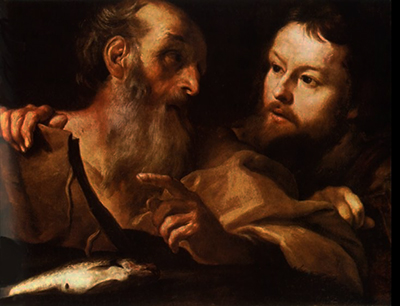Saint Andrew and Saint Thomas artwork is among the few paintings of Bernini, and it is currently located in London in the United Kingdom in the National Gallery.
Saint Andrew sits on the left side of the artwork holding a scroll. Beneath the scroll, lies a fish on the table, which references the origin of St. Andrew as a fisherman. Andrew is facing Saint Thomas, and he is pointing toward the viewer with his hand. With this thoughtful gesture, Saint Andrew has become a rhetorical figure that draws the attention of the viewer towards the artwork. The viewer is also attracted to the painting by the real closeness depicted by the scene. By luring the attention of the viewers, Gian makes the viewers feel both emotionally and physically closer to the image.
When close to this image, the sharp contrast between the light illuminating the faces of the men especially Saint Thomas and the dark background becomes quite visible. This technique commonly used in Baroque paintings is used to depict the significance of a character as well as to show the importance of a particular moment. You can see the two men engaged in a conversation, and most probably discussing some aspects of the Christian faith. The shading, or chiaroscuro, of the figures, mainly meant to emulate the depth and the shadows of the sculpture saturate the painting with a great sense of depth. The visible combination of Gian's sizing and placement of the images relative to each other strengthens the perceived depth, which enhances the scene's verisimilitude in turn.
This artwork also depicts a simple example of enthusiasm, which a major character when it comes to Baroque art. The movement denoted by their mouths and posture allows another still medium to narrate a much bigger story; with this vigour, the viewer can easily imagine the two church patriarchs in a lively conversation about their faith. The very illustration of this important moment also informs the viewer about the personal roles of these patriarchs in church. That depicts the condition of the church during the Counter-Reformation period when it was focused more on new discussions and internal debates.
It is worth noting that unlike portraits of saints before Baroque, Saints Thomas and Andrew portrays the two men as two ordinary individuals, not as divine characters or idealised symbols of power. This representation style which later became popular during the Baroque era also reinforces the narrative's believability and makes the viewer feel closer to the two figures. By portraying the saints as ordinary people, Gian allows the viewers to identify with these distant figures. That supports the individual experiences that served as a motivation for Baroque art.
With the careful use of shading and lighting, the reality with which he portrays the all the characters, as well as the lively depiction of the entire scene, Bernini developed a masterpiece that easily connects with the viewers and allowing them to reflect their relationships with the two saints, the church and God.




